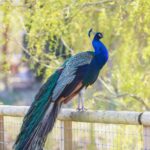Like a lot of states across America, there are wild peacocks in Georgia.
Peafowl have taken up residency in most of the large metro cities, too. Not just the more rural areas - much to the bemusement of a lot of residents.
Some of the areas (that might surprise you) where large numbers of peacocks can be found include; Savannah, Atlanta, Columbus, Augusta, Macon, Roswell, and Sandy Springs.
If you’re wondering why there are wild peacocks roaming around Georgia, how they first became wild, or anything else to do with these fascinating birds, please read on!
Table of Contents
Where Are Wild Peacocks in Georgia?
It’s easier to say that there are wild peacocks all over Georgia than it is to list all the cities and areas where they’ve been spotted.
Sure, it’s not a common sight to see a peacock flying overhead (they can only fly short distances anyway), or spot one on the sidewalk.
But wild peafowl really are living all over the state of Georgia.
If you wanted to go out of your way to find some wild peacocks, I’d suggest taking to social media and asking where they’ve been spotted.
Related - More on wild peacocks in Washington State and Ontario.
How Did Peacocks Become Wild in Georgia?
Peafowl are not native to Georgia. In fact, they’re not native to the US at all.
Wild peafowl can be found all across the US, and it’s always hard to pinpoint exactly where and how they first became ‘wild’.
According to a spokesperson for the Georgia Department of Natural Resources, it’s assumed that the first wild peafowl escaped from an enclosure.
Peafowls are kept as pets, and like a lot of birds, it’s not that hard to believe that some will have escaped at some point.
With peafowl being so adept at surviving in the wild, it’s no surprise that they’ve been able to thrive and grow in numbers.
Peafowl can also fly around a mile at a time. They can cover some ground over time, so it’s perfectly reasonable to assume they first crossed state borders, too!
Where Are Peacocks Native To?
First of all, to clear up a common misconception;
Peacocks are male peafowl, which is a species of bird, and females are called peahens.
Most people refer to peafowl as peacocks because it’s the peacocks that have large, colorful tail displays and are more commonly seen at amusement parks and other attractions.
Peahens are rather bland-looking as is often the case in the animal kingdom. They’re a brown/beige color and don’t have those distinctive long tail trains.
Back on topic; there are three main species of peacocks and this is where they’re native to:
Indian Peafowl - This is the most common species of peafowl, the type you’re used to seeing with the iridescent blue and green colored feathers.
They’re native to India, as the name suggests, and are even the national bird of India.
Green Peafowl - The Green Peafowl, also called the Indonesian Peafowl, has green feathers as opposed to blue as the name suggests.
They’re native to Southeast Asia and live in the tropical rainforests. This species is actually listed as being endangered by the IUCN.
Congo Peafowl - The Congo Peafowl, also called the African Peafowl is native to the Democratic Republic of the Congo, Africa.
This species is listed as vulnerable by the IUCN, so it’s far from thriving just like the Green Peafowl.
Related - The problems wild peafowl are causing in Florida and Michigan.
Are Wild Peacocks a Nuisance?
There is no doubt that peafowl are not well equipped to live in residential areas amongst people.
Peafowl, and peacocks, in particular, are popular attractions in parks and other communal areas, but it’s a different story when you live near some.
There are a few issues with wild peacocks:
Noise - Peacocks can be noisy, particularly during mating season which typically runs from early spring to early autumn.
They let out a distinctive high-pitched honking sound. The kind of noise you expect to hear in a rainforest, not your local neighborhood!
Damage to property - Peacocks are large birds, which means they have large claws and strong beaks.
Much like chickens they’ll scratch around for food and will think nothing of digging up plants in your yard.
Peafowl are also known for damaging vehicles. It’s believed that they get spooked or feel aggressive towards their own reflections in a vehicle’s bodywork and will attack it.
So, while it’s not guaranteed that peafowl will be a nuisance, does it sound like seeing these beautiful birds is worth it?
In Summary
Some Georgian residents love having them around, and some hate it.
Either way, you can find wild peacocks across Georgia and the numbers are only increasing year on year.
You’re not permitted to harm peafowl in the state of Georgia. Peafowl are not protected by federal laws, but they are protected by animal cruelty laws.
If wild peafowl are causing a nuisance, you need to talk to your local office to find a lawful and humane solution.
Resources
Image credits - Photo by Sagar Kulkarni on Unsplash




